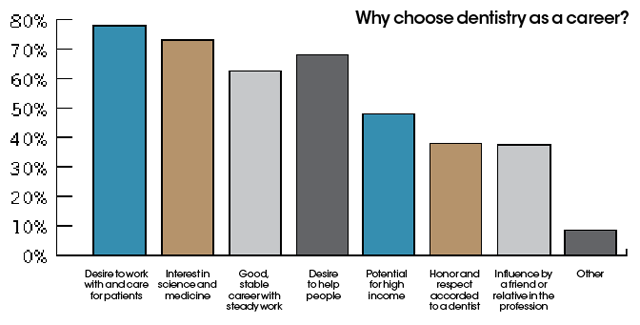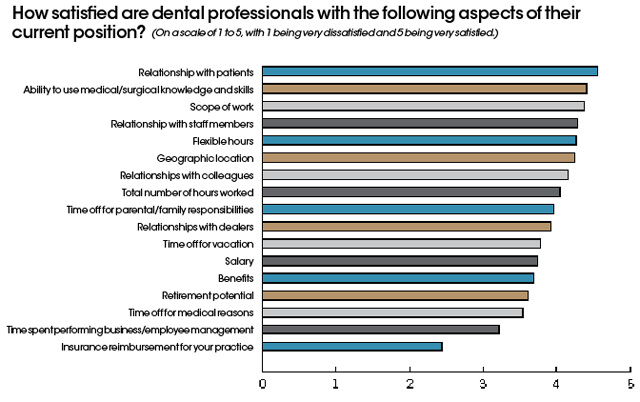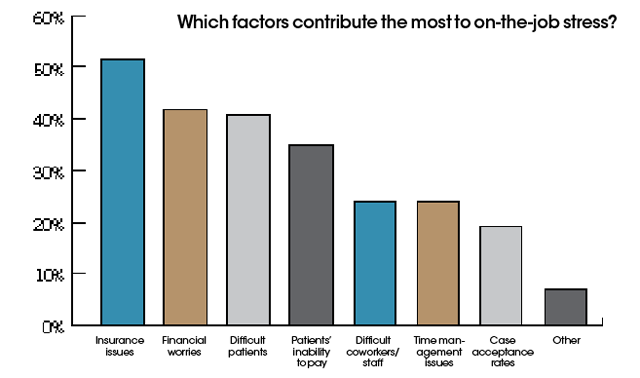The mental state of today's dentist: Part 1
Let’s face it: Being a dentist isn’t easy.

Let’s face it: Being a dentist isn’t easy.
You’re not just running a dental practice. You’re running a small business that is also your livelihood. You’re running a small business that requires you to stay up on the latest trends and techniques, hire (and fire) team members who are an extension of you and your business and improve the lives of your patients even if they don’t necessarily want to be in your chair.
More from January's issue: To encrypt or not to encrypt… It’s not really a question!
It’s a tough gig that is demanding and can be draining. You came out of dental school wanting to help people have a better smile and better oral health, yet you battle on a daily basis with holes in your schedule, team members who don’t exactly get along and patients who think you’re way, way too much like Steve Martin in “Little Shop of Horrors.”
At Dental Products Report, we do everything we can to keep you up to speed on the latest dental products and advancements within the industry. It’s one of the reasons we launched Dental Practice Management as a way to help you maintain your business and keep that bottom line strong and growing. Yes, we have done all of that and will continue doing that in 2016. However, to kick off the New Year, we wanted to do something that didn’t look at how dentists were doing clinically or business-wise, but rather how they were feeling about their chosen career and the daily triumphs and struggles they face.
Continue to page two for more...
With that, we present to you the inaugural “State of the Dentist” article. We asked our readers to take part in an extensive survey, and 635 dentists from around the country answered our call. We’ve sorted through the data and pulled out some tidbits for this article. We will focus on other aspects of the survey throughout the year in DPR and also share other data points from the survey online throughout the year on our Modern Dental Network at moderndentalnetwork.com.
One of the biggest things we wanted to know was why dentists became dentists. As expected, the most popular answer was “a desire to work with and care for patients.” However, one of the biggest surprises was the low number of dentists who answered for “honor and respect accorded to a dentist.”
Hand pain in the dental practice: When it's not carpal tunnel

Hot read: Four simple systems to get your office in tip-top shape
Continue to page three for more...
“I have always said I would never make a million dollars a year doing dentistry, but that didn’t matter. I love the patient care and interaction,” said Dr. Sheri Doniger, who practices in Lincolnwood, Ill., and is a member of the DPR Editorial Advisory Board. “Every patient is different even if you are doing the same procedure on four people in a row. As a continuous researcher, the science aspect of dentistry is always fascinating. After practicing more than 32 years, seeing trends evolve and solving dental problems is something that, to this day, is rewarding.”
While Dr. Doniger and many of her colleagues chose their profession to work with patients, they made it very clear to us that their biggest pain point had nothing to do with patient interaction but rather the insurance that many of their patients carry. On a scale of 1-5, we asked dentists to rate their satisfaction with various parts of their day. The highest was “relationship with patients” at 4.56, while the lowest-by far-was insurance reimbursement for the practice, at 2.43. It was the only answer to the questions we offered that fell below 3.0.
Related reading: Dr. Flucke's top 5 test drives of 2015

Interesting reading: The top 10 Dentrix features you probably aren't using
Continue to page four for more...
“The biggest factor in any practice is fiscal management and patient loyalty,” Dr. Doniger said. “Times have changed. When I first started my practice, patients were around for life. Now, there is less of that loyalty. This is partly due to the economy, demographic shifts and dental benefit coverage.
“The battle with benefit companies has not changed from the inception of coverage,” she continued. “Some companies still have the same $1,000 of coverage as 30 years ago, which will not cover a whole lot of dentistry outside of prevention. We always have to explain that we are the clinical practitioner, deciding with the patient on an appropriate treatment plan, and not the dental benefit company and their monetary restrictions. Patients are always slower to pay professional fees. We ‘don’t need the money.’ Some patients just don’t have the funds to spend on proper dental care. With the onset of discounted dental programs and coupons, we are seeing a decrease in specific sectors of the population. Whereas kids of boomers and Gen Yers had gone to the dentist (covered by their parents), now that they are on their own, they do not consider dental health as a priority, especially if they have no dental benefit.”
More on insurance: Discussing whether your dental practice should hire an insurance coordinator
Insurance isn’t just something dentists seem to loathe, but it’s also something that contributes to a great deal of their on-the-job stress. Of our respondents, 51.4 percent said insurance contributed to raising their blood pressure followed by financial worries (41.9 percent) and difficult patients (40.6 percent).
We asked Teresa Duncan, DPR’s insurance editor, for her thoughts on the insurance survey results.
“More than half of the survey respondents cited insurance reimbursement as a source of stress in their practices,” she said. “The logical conclusion is that they’re referring to lower or unsatisfactory reimbursement. During my travels around the country, I hear from audiences who are upset with insurance processing, the lowering of rates and the increased scrutiny PPO providers endure. Occasionally, I hear from offices that are satisfied with reimbursement levels, but those plans are few and far between.
Continue to page five for more...

Related reading: 5 insurance actions you can take now for a smooth 2016
“A frequent seminar question is, ‘How do offices make it work?’ The easy answer is that they are efficient and take precautions to lower their financial risk. The more complicated answer is there is a system that needs to be established in an insurance office. This means checking eligibility and benefits religiously, utilizing electronic capabilities to send claims and attachments and tracking the metrics associated with your insurance revenues. The majority of offices have one or two pieces in place but not the whole system. You can always start today by investigating your own process.
Hot read: 4 myths about money and the dental practice
“A more complicated piece of the puzzle is to adjust expectations. Veteran doctors (and managers like myself!) remember the ‘good old days’ of easy submission and payment. The most difficult issue was figuring out the rare secondary insurance protocol! Younger doctors who sign up with plans now do not expect easy or high reimbursement. Their expectations are more in line with their office’s reality. It was difficult to type this last paragraph as I have seen such a huge change in just 20 years in our insurance environment. I don’t like to read survey results like these, but, again, they’re our reality. What can you do? Assess what office systems you can improve now. That is what you have current control over.”
One of our respondents summed up a lot of your feelings with his very short answer to an open-ended question on how dentists feel about their jobs: “Dentistry is hard. I try to do the best I can.”
We hear you. It’s our goal this year and beyond to bring you the information we can to lower your stress and raise your level of success.
More on planning for 2016: 4 tips to setting realistic goals for 2016